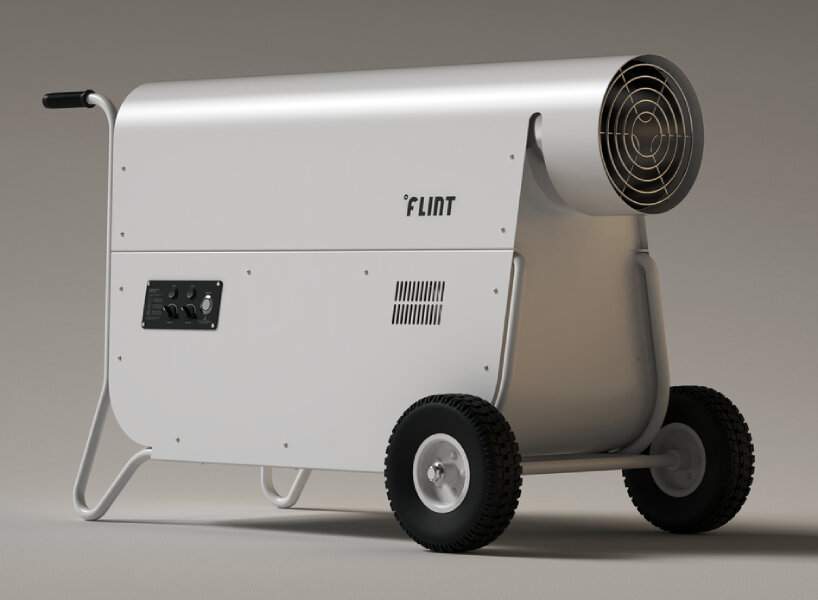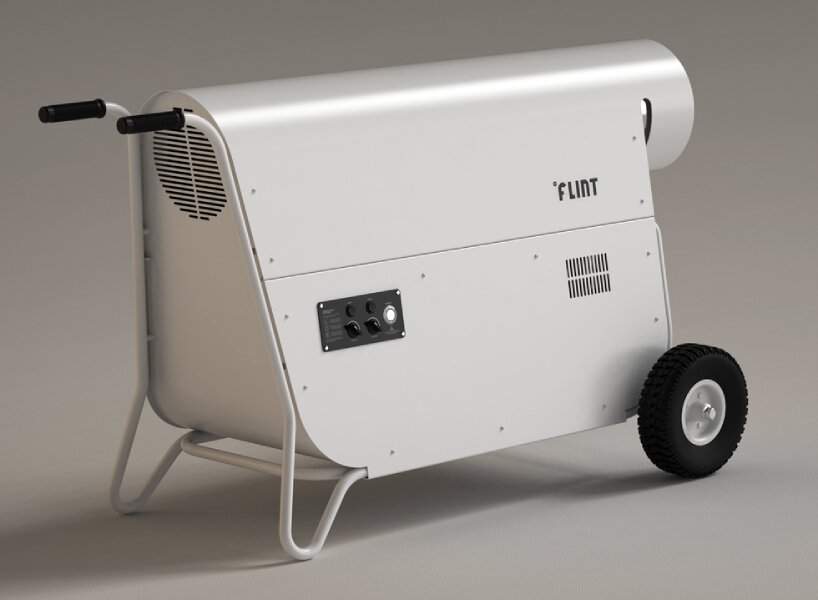Cooking oil inside flint bioheater
Flint Bioheater by Unichest warms up rooms and spaces by using and recycling cooking oil as its fuel, reducing carbon emissions and grave climate-change repercussions as the product’s company believes. The design resembles a surveillance camera or a home-technology device in industrial size. The wheelbarrow style allows its users to lug the bioheater to different places without needing to drag it. The inside of Flint bioheater (see picture below) incorporates steel as its primary material, and color variations are also available which include black, silver, and orange.

images courtesy of Unichest
flint bioheater for leftover oil
Korean energy company Flint adopts a combustion technology that incinerates natural-oil fuel without chemicals which include – but are not limited to – cooking, animal fats, plant, microalgae, coffee, and insect oil. The company believes that cleaner and more economical energy is available almost everywhere, and its technologies aim to allow users to use their leftover oil as fuels, produced at a low cost without additional processing.

eco-friendly ‘Flint Bioheater’ uses cooking oil as fuel to release heat
Unichest designed flint bioheater
To materialize their vision, the company tapped design studio Unichest to develop the style and prototype of a heater that would enable the use of cooking oil as the main driver that would make the heater work. Unichest’s team – comprising Cho Sunghwan, Lee Sooyeol, Park Yeongeun, Yang Sihoon, and Lee Hyunju – unveiled Flint Bioheater in 2021, a bioheater that uses cooking oil as fuel and uses a combustion module to transfer heat. The team created a design based on easy-parts composition and manufacturing method that make use of details and show a neat and minimal appearance that goes well with the cluttered farm atmosphere.

side view of the heater
From animal and plant oil to biodiesel
Flint says that even though animal and plant oil can be regarded as environmentally friendly and has a high rate of continuous production, this type of oil has a high flash point and viscosity that makes them difficult to achieve ignition. The company’s approach is to convert this kind of oil to biodiesel through a chemical process, but doing so by directly burning them without refining the chemical procedures. The company believes that by continuing this process and installing the feature into its products, it will hardly emit harmful carbon, keeping then the atmosphere clean and renewable.

view inside
Household and outdoor air pollution
Flint bioheater is a substitute for using fossil fuel and biomass which gravely harm the environment and is an alternative to coal heating. The company says that in winter, houses in Asian cities use coal stoves that contribute to the worsening case of air pollution. Based on 2016 research by the University of British Columbia, more than 5.5 million people die prematurely every year because of household and outdoor air pollution, and more than half of the deaths happen in China and India.
Flint – it aims to add more in the future – has developed its own combustion engine that burns contaminants in the exhausted gas with high temperature and clean combustion. ‘It is possible to reduce the amount of soot generated by incomplete combustion significantly and to reduce the heating cost with high thermal efficiency,’ says Flint.


